Straight from the Heart and Soul of Italy, Highly Coveted Artisanal Extra Virgin Olive Oils Rushed to You at Their Height of Flavor and Freshness
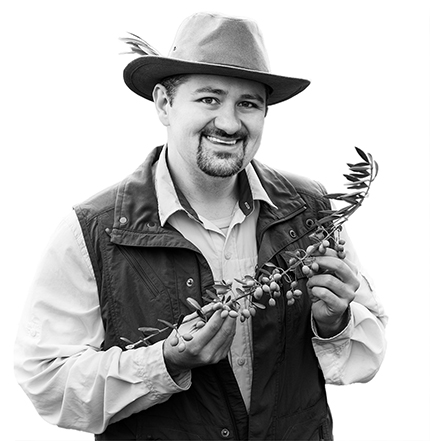
- Each of these exclusive olive oils perfectly embodies the flavor characteristics of its region and was meticulously crafted from cultivars nurtured on award-winning family farms.
- The best of the best has been secured just for you, as the world experiences an EVOO shortage never before seen.
- All three oils have been certified by an independent lab to be 100 percent extra virgin olive oil, brimming with healthful and zesty polyphenols to wow your palate.
Landing in Rome, the Eternal City and my launching pad when hunting for fresh-pressed olive oils in Italy, is something I look forward to every year—visits to historic villages, reuniting with producers who have become friends, and, of course, the food. But I embarked on this journey with some trepidation.
As longstanding Club members know, my search for the world’s greatest extra virgin olive oil is largely influenced by Mother Nature. She determines so many aspects of olive cultivation, right down to harvest dates. But when the consequences of her handiwork make the front page of the New York Times with the headline “Why Olive Oil Is So Expensive Right Now,” well, you can imagine how serious the situation was. Less available fruit, lower yield, higher prices. Every last drop was in high demand, and I knew this quarter that I was going to rely heavily on the relationships I’ve nurtured for nearly two decades. I also knew that nothing would stop me from coming home with the very finest liquid gold for you!
A Year Unlike Any Other
Concerns had been swirling since late spring. To quote master miller, olive whisperer, and perma-member of my Merry Band of Tasters, Duccio Morozzo della Rocca, “There has never been a year as complicated as this one and with as little extra virgin olive oil throughout the entire Mediterranean area—the last few months were unlike any pattern the olive trees were used to.”
The typical growing season goes like this: spring rains lead to olive blossoms emerging in May and June, hot weather through August encourages growth, some rain in September nurtures the trees, and the temperatures cool in October. This year, the spring rains lasted well into June, with heavy downpours knocking many blossoms off the trees—no flowers, no olives. For those growers who did have some olives, the second shoe to drop was the streak of summer-like temperatures lasting well into November. You can’t make flavorful olive oil when the weather and the olives themselves are hot. That’s why recent innovations at top mills have been focused on chilling—cooling down each step of the process to preserve the aromas and flavors when the olives are pressed.
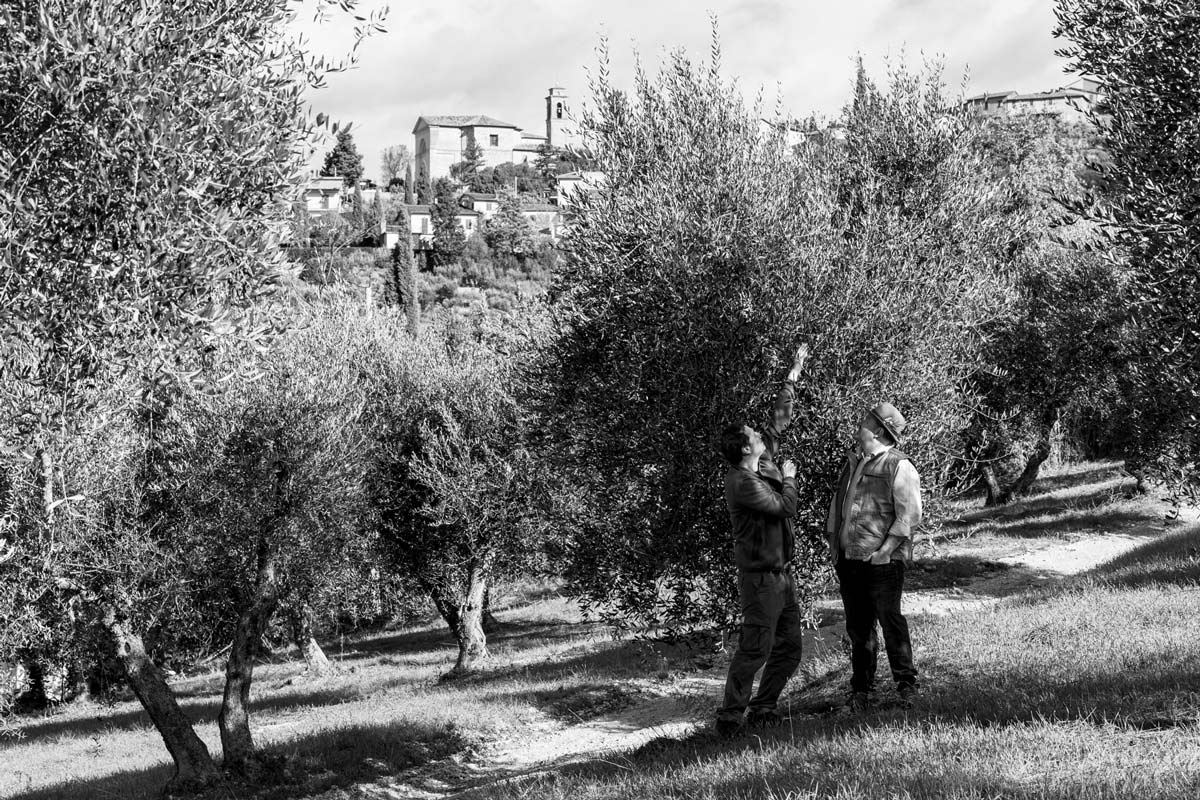
The Fruits of Strong Relationships
The heightened urgency of the hunt set the cadence of our trip—after just one night in Rome, we hit the ground running. Duccio and I had already been in touch with the country’s most highly skilled, award-winning producers. It was heartbreaking to hear how many simply had no oil available, but then a relief to learn that a few had successful harvests because their groves stretched across many microclimates, yielding great fruit and great oil.
As always, though, the proof is in the pudding—would these oils be of the exceptional quality I insist on and you expect? After our rounds of tastings, I’m happy to answer with an emphatic “Yes!” Each one is deliciously unique, and together they represent three very important and distinct olive growing regions of Italy. And our producers were thrilled to know that their precious oil would be enjoyed by people who truly appreciate it—you, my dear Club members.

Making Memorable Oils and New Memories
As my apprehensions faded away, my excitement and joy over being back in Italy swelled with every stop we made. What a pleasure to once again spend time around the table with my producer families, catching up on their news and sharing amazing food—platters of salumi, bowls of fresh pasta, and fabulous meats and seafood, all of it enhanced by just-pressed olive oil.
My Merry Band of Tasters and I first traveled to Penne in Abruzzo, to Frantoio Mercurius, the family operation of my good friend Claudio Di Mercurio. I was happy to congratulate him in person for his recent silver star win at the famed Sol d’Oro competition! Claudio’s dedication to the land and meticulous care of his olive trees has made him a formidable match for Mother Nature. His Dritta varietal, the most consistent grower, is the star of this trio’s bold oil.
Many locals come to Claudio’s frantoio, or mill, with their own olives to press, perhaps none more respected than Luciano Di Giovacchino, one of Italy’s pioneering olive oil scientists. It says a lot that this esteemed expert chooses Claudio’s frantoio to press his own olives, and, although the Mercurius mill is extremely modern, the convivial atmosphere of bringing one’s homegrown olives to a community mill is a centuries-old part of the social fabric of this town as it is in so many others.

Then it was on to the historic town of Trevi, in Umbria, the heart of Italy, to work with the Brunetti family. I’m elated to introduce to the Club not only this amazing producer but also to a wonderful indigenous varietal called San Felice, a highlight of this quarter’s mild oil.
From there it was off to Sicily to reunite with Salvatore Cutrera. He says that each harvest is always a nail biter until the olives are pressed and the beautiful fresh green perfume of extra virgin olive oil fills the air in the mill. This quarter’s medium selection is made with the exquisite Nocellara del Belice, a cultivar from the Valle del Belice area, and it brought only smiles to both our faces.
I invite you to read more about each of these amazing producers and then indulge in the Pressing Report recipes to share with friends and family—you’ll be transported to Italy with every bite.
Happy drizzling!

T. J. Robinson
The Olive Oil Hunter®
This Quarter’s First Selection
- Producer: Famiglia Brunetti, Trevi, Umbria, Italy 2023
- Olive Varieties: Moraiolo, San Felice, Frantoio, Leccino
- Flavor Profile: Mild
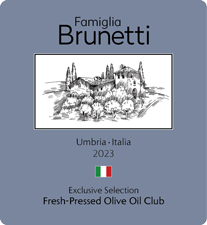
The excitement was palpable when my Merry Band of Tasters and I departed Abruzzo in Duccio’s car. Our destination? A new producer, the Brunetti family, in the picturesque Umbrian hill town of Trevi, home of an olive tree estimated to be 1,700 years old. It was a two-hour drive, plenty of time to savor how perseverance and carefully tended relationships with the world’s top olive oil experts and producers have favored the Olive Oil Hunter and his Club members during this most challenging harvest year.
Located mid-calf on the Italian boot, land-locked Umbria is known as “the green heart of Italy.” Italians have long lauded the region’s high-quality olive oils and wines, the former resurrected by monks during the Middle Ages after centuries of war, civil strife, and neglect.
Equally as excited to meet us were the Brunetti family and their friendly dog, a truffle-hunting Lagotto Romagnolo named Lilla. (Umbria is second only to Piemonte in its harvest of truffles.) Brothers Andrea and Stefano were proud to show us around their mill and thriving olive groves. To my delight, we toured the farm in a vintage Ape that was small enough to negotiate the groves’ grassy aisles.
Finally, we returned to the mill for the tasting I had so eagerly anticipated. The brothers offered their finest liquid gold to us to “play” with. Duccio and I got right to work—tasting, blending, and re-tasting. Hours later, we hit on an incredible blend of cultivars Moraiolo, Frantoio, Leccino, and San Felice. The latter, a smallish drupe indigenous to the area (one of 550 varietals grown in Italy), is new to the Club’s repertoire. I am so pleased to introduce you to it. I love the spicy and grassy notes it adds—the key to perfectly calibrated flavor and balance.
Like any family producing high-quality extra virgin olive oil, the Brunettis have a story to tell. Andrea and Stefano’s grandfather, Vittorio, owned thousands of trees in the area in the 1950s. But postwar pragmatism led him to sell his groves, retaining about 200 trees for the family’s use. Meanwhile, his son Francesco went to work in the aviation industry. In 1994, Francesco, tiring of the corporate world, steered the family back to its roots and began the long and arduous process of expanding the groves and cultivating amazing olives. Today, his sons care for 45,000 trees spread over three microclimates at varying elevations. The reopened mill, now outfitted with state-of-the-art equipment from Alfa Laval, allows precise temperature control of the olives and olive paste, a critical tool in the hands of any miller intent on producing the highest-quality EVOO. The family’s hard work has paid off, as evidenced by their many prestigious awards—among them inclusion in Flos Olei’s Top 20 and Gambero Rosso’s coveted star honoring a decade of excellence.
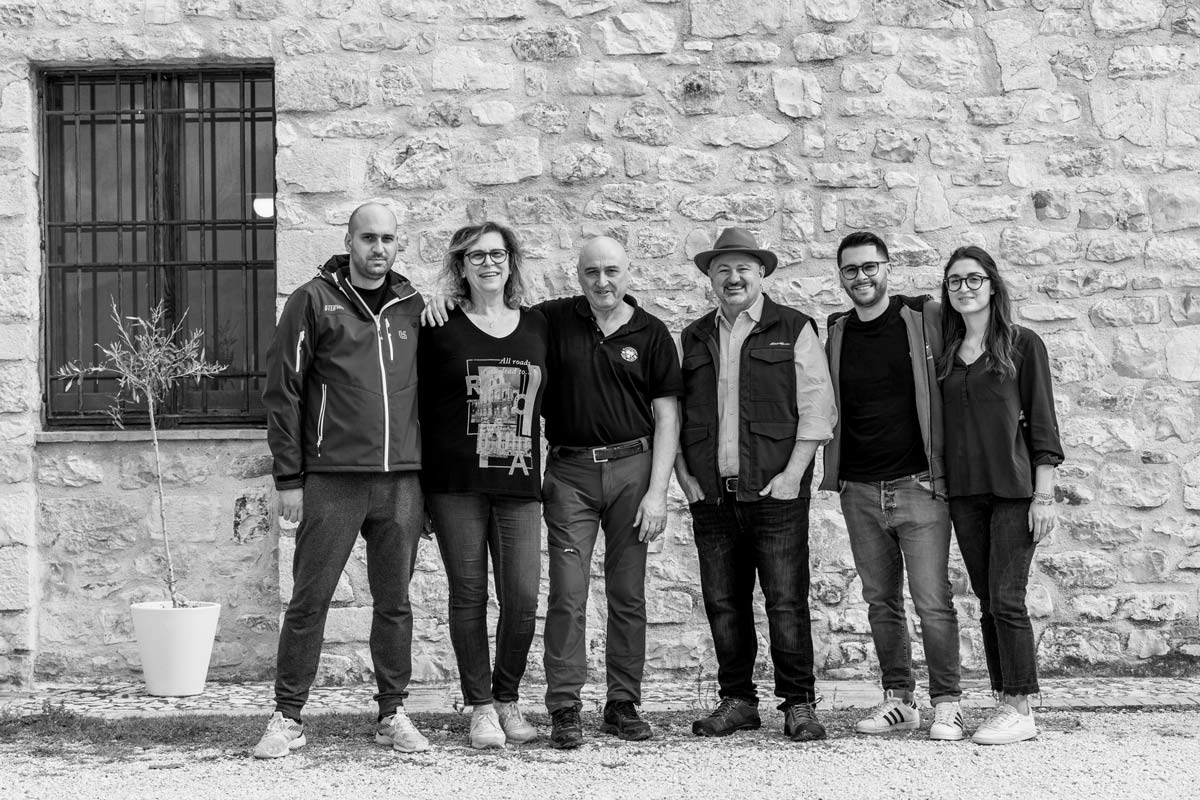
There’s nothing like tasting quality olive oils to whet appetites, of course. My favorite meal of the visit was a simple but absolutely delicious pasta e fagioli. Prepared by Stefano’s wife, Marianna, it contained carrots, celery, onion, cabbage, tomatoes, cannellini beans, peas, vegetable broth, and a special pasta from her village called cubetti. This was our first family meal together, hosted in a private room at the back of the mill. It was evident many meals happen around this table; I was deeply humbled to be offered a seat. We ladled the thick, warm soup into our bowls, then lavishly topped them with freshly grated Parmesan and glugs of fresh olive oil. Meanwhile, Stefano’s exuberant two-year-old, Francesco, cavorted happily around us. It was obvious he was very comfortable using the mill as his personal playground.
As a final farewell to Umbria and our new friends and partners, my Merry Band of Tasters and I eagerly accepted an invitation to visit a restaurant in the heart of medieval Trevi, Osteria La Vecchia Posta, with Andrea and his wife, Ilaria. Toting a bottle of our newly created blend, we entered the eatery from the town square, which is dominated by a thirteenth-century watch tower. A highlight of the meal was a seasonal dish featuring black celery, a vegetable unique to Trevi. (Only five local farms are authorized to grow this special celery, which, contrary to its name, is actually green.) When splashed with our Club’s exclusive blend it was a perfect way to close out our time in Trevi. I know this splendid oil will bring much joy to your winter table, too. Buon Appetito!

Impressions and Recommended Food Pairings
From the heart of Umbria, this wonderful oil features San Felice, a prized olive varietal new to the Club. On the nose, we sensed the aroma of freshly cut grass, along with artichoke, green almond, apple, green banana, and escarole. There’s also the sweet scent of fennel, mint, and vanilla. On the palate, this oil comes alive with artichoke, spinach, and rosemary; a bitterness reminiscent of dandelion greens; and a pleasant spiciness that evokes celery leaves and white pepper.
It will lusciously enhance citrus salads, bean and other legume dishes including soups like pasta e ceci; risottos; potatoes; sauteed wild mushrooms or cabbage; and other cruciferous veggies. Drizzle it over freshly steamed artichokes or cold artichokes in vinaigrette. It’s delectable on grilled octopus or shrimp; on dishes featuring chicken, turkey, rabbit, or lamb; and in baked goods.
This Quarter’s Second Selection
- Producer: Salvatore Cutrera Exclusive Signature Selection, Chiaramonte Gulfi, Ragusa, Sicily, Italy 2023
- Olive Varieties: Nocellara del Belice
- Flavor Profile: Medium
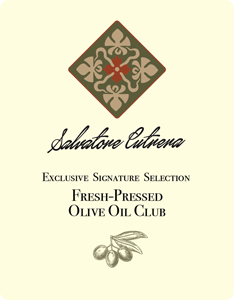
Salvatore Cutrera is one of the most driven, provocative characters I’ve encountered during two decades of olive oil hunting. I smile when I remember our first meeting in 2017: evidently testing the palates of myself and my Merry Band of Tasters, Salvatore seeded our inaugural tasting with several unremarkable oils. It was only when we proved ourselves to be very discriminating that he shared his “secret stash” of his finest oils with us. This “vetting” indicated to me that the value Salvatore places on his precious oils cannot be underestimated. He simply doesn’t want to sell them to anyone who can’t or won’t appreciate them. We have made his cut, dear Club member!
The Cutrera family has been involved in the olive oil business since 1906. In 1979, Salvatore’s father, Giovanni, established an olive mill adjacent to the family home in Chiaramonte Gulfi, a beautiful village in southeastern Sicily that’s been called the “Balcony of Sicily,” thanks to its stunning views of the Hyblean Mountains and the irascible Mount Etna. Salvatore’s wife, son, sisters, in-laws, and other extended family members now staff the business, which comprises some 250 acres of native olive trees and an incredible multi-purpose building about 600 yards from the original mill. Duccio calls it “a cathedral of olive oil.”
Opened in 2021 and encompassing 85,000 square feet, it is a truly magnificent facility, unique in Italy and the world. It features a light-filled classroom for education and tastings as well as top-of-the-line milling equipment from innovative companies Mori and Pieralisi. Dual machinery arrays enable Salvatore and his team to test which equipment works best for individual batches of olives. (No wonder Frantoi Cutrera has won over 700 awards and inclusion in Flos Olei’s Top 20 multiple times!)
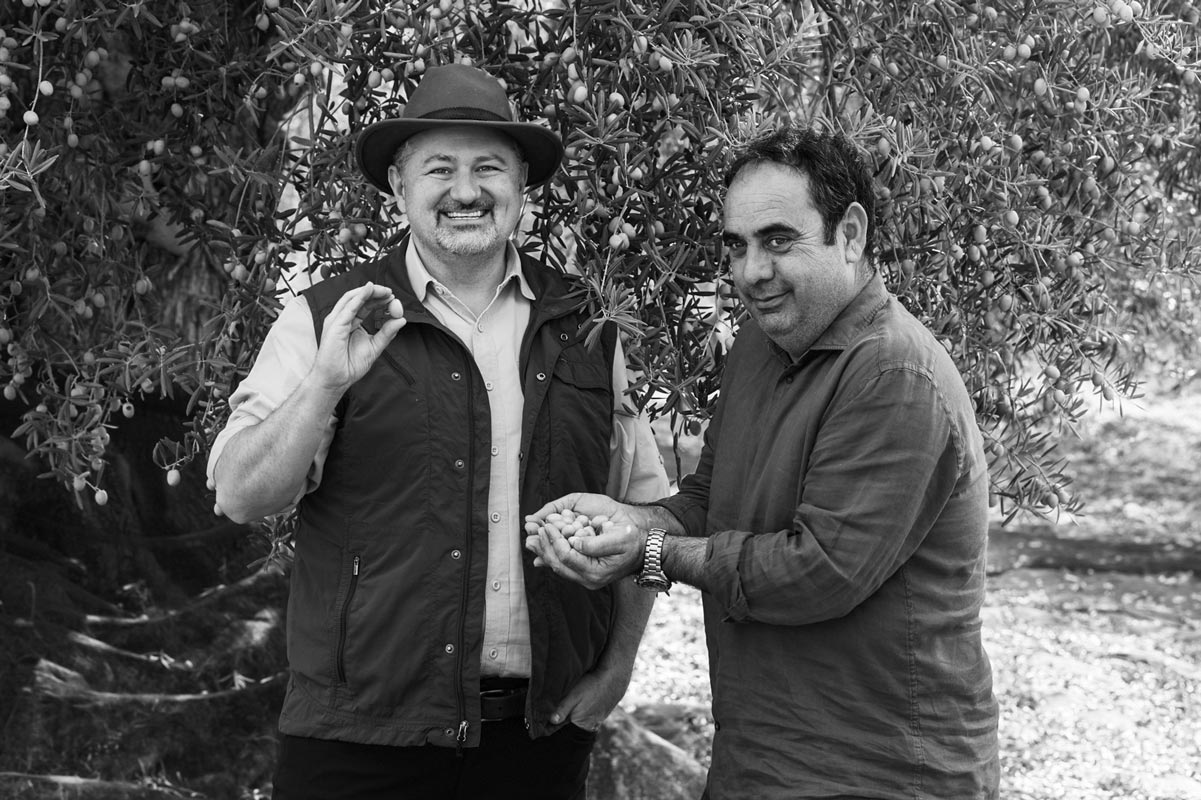
Salvatore is especially proud of two high-tech sorters that identify and dispatch with puffs of air any flawed olive specimens (he calls them “mummies”) with ruthless precision. The system is fascinating to me. Salvatore claims Mother Nature herself is the best judge of olive quality, sometimes condemning substandard fruit to the ground with her windy wrath.
Understandably, given the dire olive news coming from Europe the last few months, I was concerned I wouldn’t be able to find the high-quality extra virgin olive oils my Club members expect. But Salvatore gave me hope. He assured me his perfectly green Nocellara del Belice olives were thriving. And, barring catastrophic weather, they would be ready for me and my team. (I love this varietal, also known as Castelvetrano, often seen on charcuterie platters.) But he was one of few Sicilian producers who had exceptional oils this season, and he was being actively pursued by other persistent buyers, many of whom were desperate to buy any oil, regardless of quality. Thankfully, Salvatore honored his commitment to me and to my Club members.
I never expected to use the word “giddy” in same sentence as “Salvatore Cutrera.” In our interactions, he has always been a bit reserved. But during my recent visit, our conversations were often punctuated by his laughter, a delightful and unexpected sound. I believe the successful harvest (after a nail-biting year) and the flawless performance of his new mill lifted anxiety off Savatore’s shoulders and gave him a certain lightness of being.
The last evening of my visit, Salvatore treated me to a memorable dinner at Ristorante U Dammusu, a local place that had special meaning to him: he’d celebrated his 18th birthday there. It’s a homey restaurant decorated with antiques. Because the area is famous for its pork dishes, I ordered gelatina di maiale (pork in aspic). Now I’m hooked, and I intend to recreate this dish at home. Naturally, we brought our just-pressed olive oil and used it liberally on our food. Salvatore seemed so happy and relaxed, and it was a great pleasure to spend time with him. He seems like a man who has realized his dream, yet he still looks eagerly toward the future and the future of his olive trees, always searching for ways to make his award-winning extra virgin olive oils even better. I hope you love this outstanding oil as much as I do.
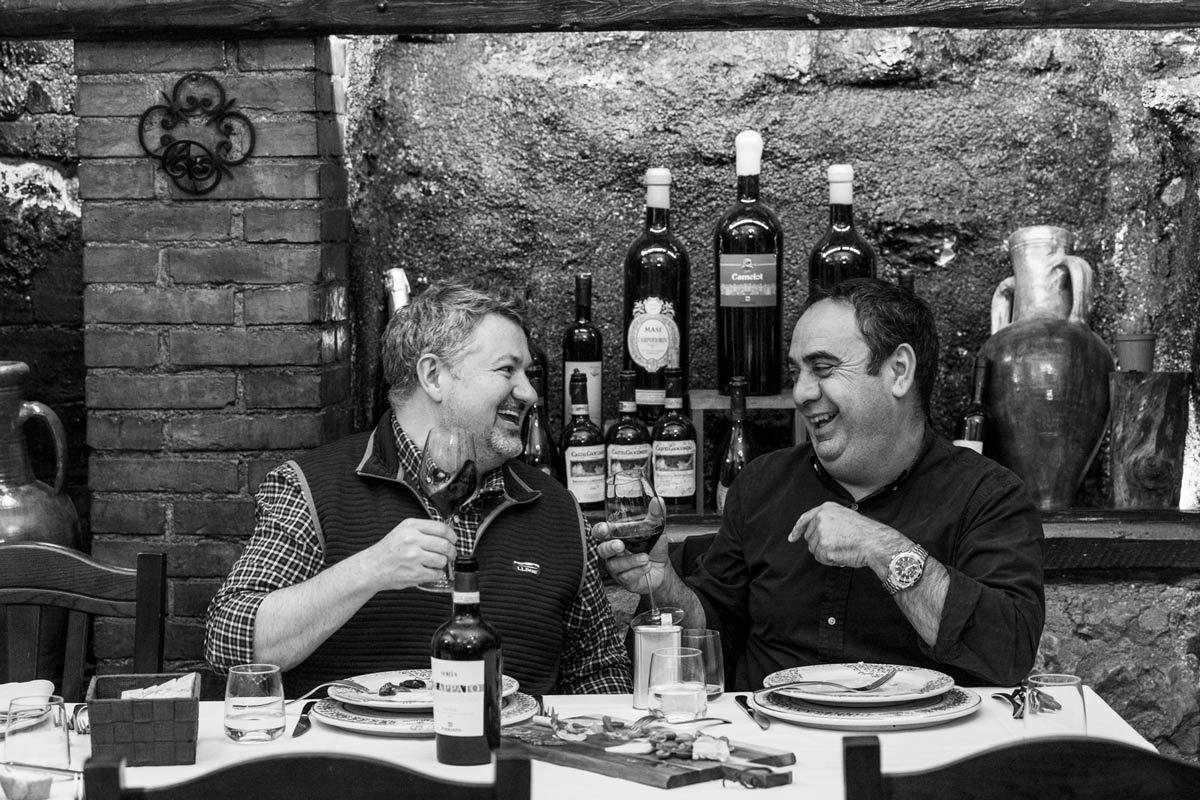
Impressions and Recommended Food Pairings
This enchanting Nocellara del Belice is Sicily in a bottle! It tempts with aromas of tomato leaf, freshly cut grass, walnut, celery, baby spinach, lemon peel, and herbal notes of dill and basil. The walnut comes through on the palate as well, along with wheatgrass, celery, the delicate fruitiness of Asian pear, and the lingering spiciness and bitterness of arugula and Szechuan peppercorns.
This oil belongs in your tomato-based recipes, from sauces to pizza to bruschetta. Use it in homemade focaccia; egg dishes like Italian breakfast strata; noodle dishes like pasta with breadcrumbs; and to braise greens and roast pumpkin, other squashes, and root vegetables. Drizzle it over avocados, rice and other grains, and grain- or legume-based sides and salads, especially those with nuts. Perfect for pork as well as fatty fish like tuna and salmon, and to enhance fruit and veggie smoothies.
This Quarter’s Third Selection
- Producer: Frantoio Mercurius, Penne, Abruzzo, Italy 2023
- Olive Varieties: Dritta
- Flavor Profile: Bold

When my Merry Band of Tasters and I pulled up to Frantoio Mercurius, near the ancient city of Penne, our dear friend, the gifted producer Claudio Di Mercurio, came out to greet us with open arms, clad in a billowy white linen shirt and white shorts. He looked like a guardian angel wearing “summer casual” on holiday. I was well aware of the unseasonably hot temperatures as I sweltered inside my safari vest, but Claudio’s out-of-sync outfit drove home the crisis conditions facing many Mediterranean olive growers this season.
Weeks before, I had been ecstatic to receive word from my scouts on the ground that, in this season characterized by uncertainty, Frantoio Mercurius looked forward to an excellent harvest. This marks the sixth year in a row—an unprecedented winning streak—that I have selected a Mercurius EVOO for our Club. Claudio and his family, pursuing perfection from the outset, produced their first ultra-premium EVOO in 2010. In that inaugural season, the farm’s oils reaped regional awards for excellence, an award-winning trend that has only strengthened over the years, including a silver medal at the recent, prestigious Sol d’Oro competition.
About 70 percent of the family’s groves are planted with a rare varietal native to the Abruzzo region, Dritta (rhymes with Rita), a small, firm fruit with a moniker that translates as “dependable, genial, trustworthy.” When I first visited the Mercurius farm, in 2018, I was astounded to encounter this cultivar I’d never heard of, and even more delighted, over the following years, to learn that it more than lives up to its name. Usually, olive trees alternate between seasons of high production and low, yet the Dritta trees at Frantoio Mercurius have produced consistently stellar fruit year after year.
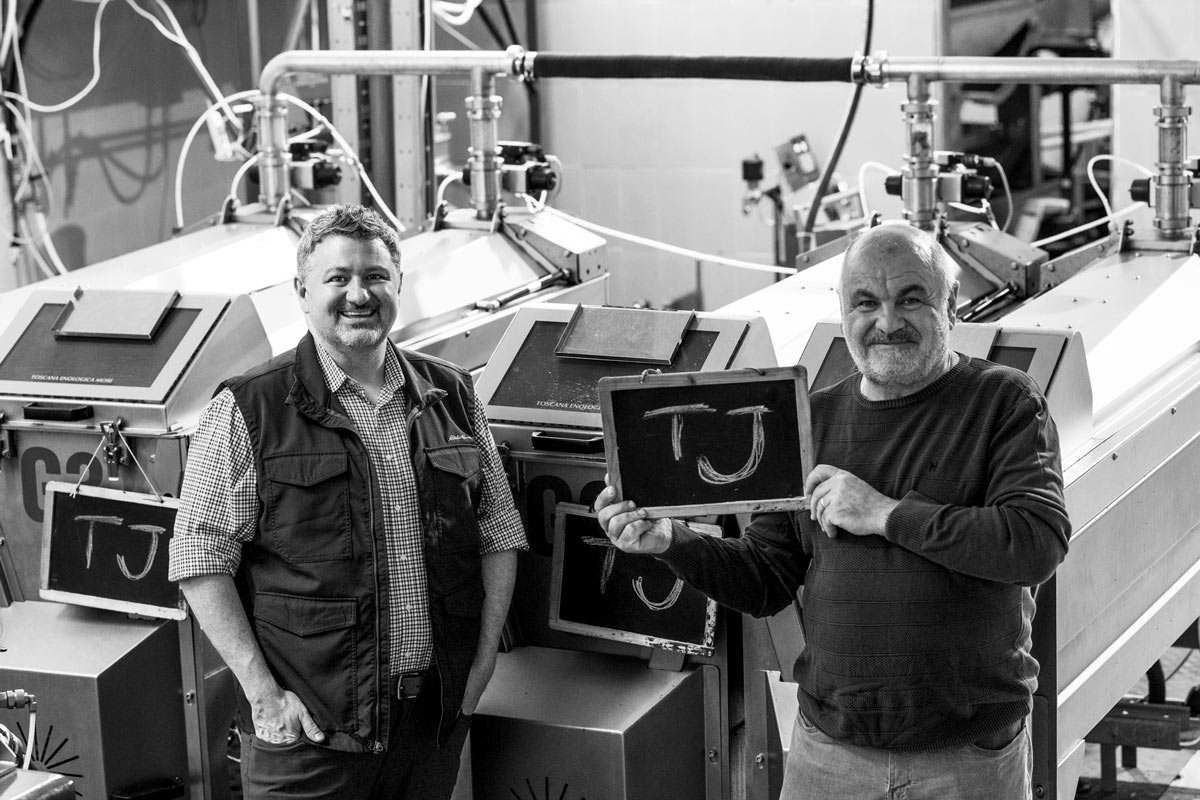
Claudio attributes the dependable excellence of Mercurius oils to the farm’s location in the Abruzzo region, south of the Appenine mountains, which divide Italy in half along its length. The diminutive, 60-acre farm is nestled in a microclimate among small mountain peaks, with the Mediterranean Sea to its east—natural geographic barriers that help protect against weather extremes. This year, though, the area was nonetheless exposed to the same large-scale trends that affected other parts of Italy.
After a banner start to the season, with enough moisture in spring to sustain vigorous trees and plenty of initial blossoming, the rain intensified and kept falling until June. The Leccino trees in the grove lost most of their flowers to the downpours. The Dritta trees, in contrast, bloomed later, exactly as the rain was tapering off, so their development was safe.
The team started the harvest extra early, during a dip in the heat, but temperatures rose again and stayed high. “Hot olives make bad oil with no aromas,” noted Claudio. The team worked when the fruit was cooler—in the early morning, in the evening, on less blistering days, stopping and starting. The technologically advanced mill employs a refrigerated crusher, installed in 2019, which keeps the olive paste cool and helps preserve the precious polyphenols and perfumes in the olives.

Not only does Frantoio Mercurius produce superlative EVOO from its own fruit, it is also where quality-minded growers across the region bring their olives to be pressed. While I was at the mill, eagerly awaiting the Dritta, I was delighted to meet a soft-spoken elderly gentleman who’d come to press his family’s olive oil for the season. His name was Luciano Di Giovacchino (see photo below). Luciano is one of the world’s foremost olive oil scientists, a pioneer in the study of organoleptics (sensory impressions, such as flavor, aroma, appearance, and mouthfeel). For 30 years, he was the director of the l’Istituto Sperimentale per la Elaiotecnica (Institute for Olive Oil Technology Research) in Pescara, where he and his colleagues developed the concept and practice of olive oil tasting panels. And here he was, bringing bins of freshly picked olives to his local olive mill, chatting with me. I felt like I had one foot in the past and one foot in the now, as Luciano told me about scaling ladders to pick olives as a boy.
I wish he’d been able to help me describe the extraordinary Dritta you have just received, but I think my Merry Band of Tasters and I have evoked it extremely well. Read on to whet your appetite for this fantastic EVOO from Frantoio Mercurius and the little varietal that could.
Impressions and Recommended Food Pairings
The essence of central Italy is captured in this oil starring the Dritta olive. On the nose, this oil is redolent of Tuscan kale and Belgian endive, almonds, baking spices, and wild mint, plus the aroma of black peppercorns and sage. Our tasters enjoyed waves of flavor—dark leafy greens; the wonderful bitterness of radicchio, cacao nibs, and green tea; and the spiciness of those peppercorns, plus notes of parsley and hazelnut.
Lavish this oil on brussels sprouts, broccoli, dark leafy greens, and string beans. Drizzle over cheese-and-salumi boards, grilled slices of crusty bread, and sliced grilled steak. Whisk into vinaigrettes for salads like insalata tricolore and artichoke carpaccio. It adds depth to tomato-based meat and sausage sauces; intensity to chocolate desserts, flourless pistachio cake, and ice cream; and zest to your morning granola and yogurt.
Olive Oil and Health
Reference: Flynn MM, Tierney A, Itsiopoulos C. Is extra virgin olive oil the critical ingredient driving the health benefits of a Mediterranean diet? Nutrients. 2023;15:2915.
A recent scientific review, published in the journal Nutrients, provides strong evidence that the phenols in EVOO—which are not present in lower grades of olive oil—play a primary role in the heart-health benefits associated with olive oil and the Mediterranean diet.
Phenols are bioactive compounds in plant-based foods. EVOO is rich in phenols, whereas refined olive oils are stripped of these health-promoting compounds by chemical production processes.
Study Objectives
Dr. Mary Flynn, PhD, registered dietician, and associate professor of medicine at Brown University, identified 34 randomized, controlled trials published between 2000 and 2022 that evaluated the effects of EVOO on risk factors for heart disease: blood pressure, levels of LDL (“bad”) and HDL (“good”) cholesterol, blood sugar, and body weight.
A main aim of the review was to isolate the effects of the phenols in EVOO from the potential effects of monounsaturated fatty acids (MUFAs), which are present in all grades of olive oil and other vegetable oils. Flynn hypothesized that the MUFA content is not responsible for the many health benefits of EVOO.
Another objective was to identify a minimum daily amount of EVOO required to experience its health benefits and the timing for improvements in heart-health risk factors to be observed.
Findings
Across the 34 studies, EVOO improved multiple risk factors for heart disease as compared to other grades of olive oil, other plant oils, and low-fat diets:
- Lowered blood pressure
- Lowered LDL and increased HDL
- Improved insulin sensitivity
- Proved effective in weight-loss diets and improved long-term weight management
Daily dose of EVOO
According to Flynn and colleagues, “Daily use of EVOO starting at approximately two tablespoons a day will improve a plethora of risk factors in as few as three weeks.”
Phenomenal phenols
It is the phenols in EVOO that confer its heart-health benefits, the authors concluded. In order to obtain optimal levels of phenols, they recommend consuming the freshest olive oil: “The phenol content of extra virgin olive oil is highest in olive oil made close to the harvesting of the olive and will decrease with age and storage. Thus, for maximum health benefits, the EVOO should be produced and consumed as close to harvesting the fruit as possible.”
The authors noted some limitations of this review: most studies did not include the specific phenolic content of the EVOO used, and many were conducted in the EU, where EVOO has been a part of the diet for centuries. More investigation, especially studies that identify the specific levels of phenols, is needed to confirm and build on these findings.
Kudos from Club Members
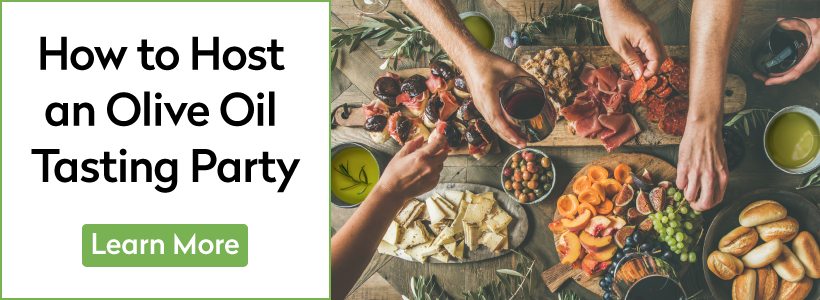
Recipes
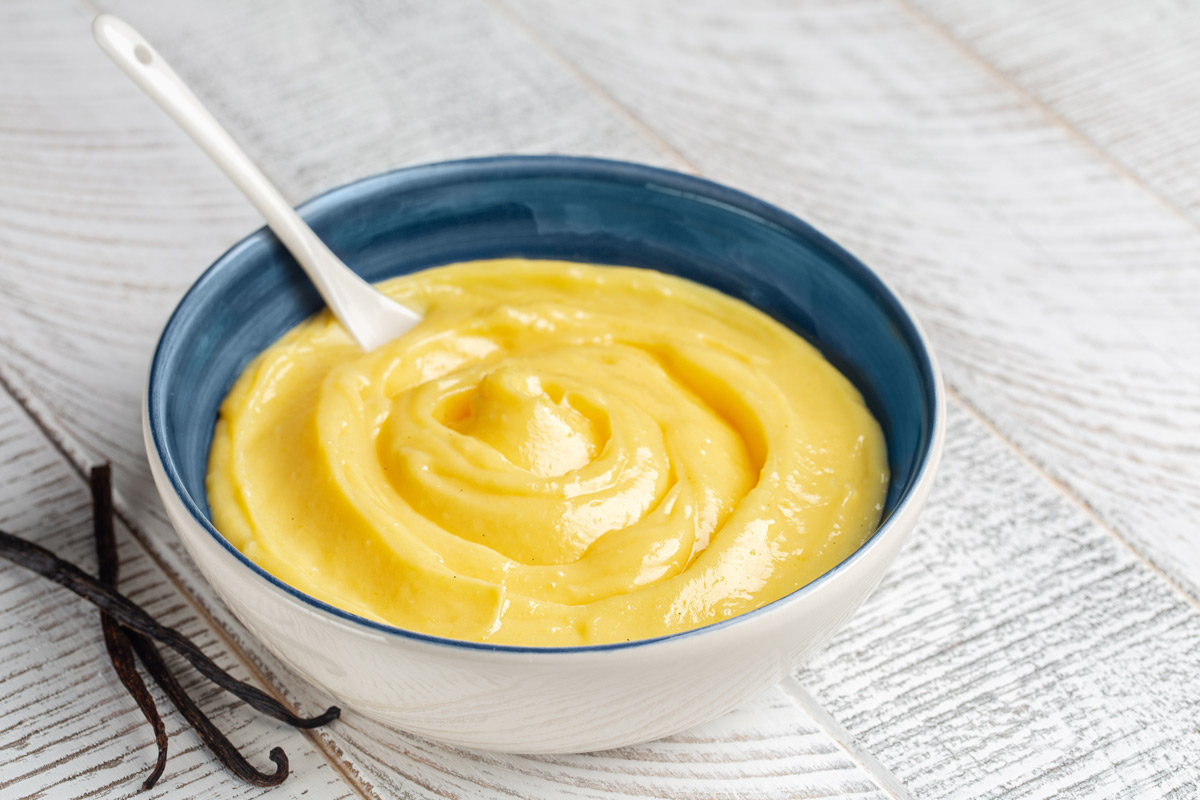 Vanilla and Olive Oil Custard Cream Delicious spooned over the Flourless Pistachio Cake, this custard also makes a luscious pudding you can enjoy on its own. Ingredients 3 tablespoons cornstarch 1/2 cup granulated sugar Pinch of fine sea salt 4 egg yolks 1 1/2 cups whole milk 1/2 cup heavy cream 2 tablespoons extra virgin olive oil 2 teaspoons pure vanilla… view recipe
Vanilla and Olive Oil Custard Cream Delicious spooned over the Flourless Pistachio Cake, this custard also makes a luscious pudding you can enjoy on its own. Ingredients 3 tablespoons cornstarch 1/2 cup granulated sugar Pinch of fine sea salt 4 egg yolks 1 1/2 cups whole milk 1/2 cup heavy cream 2 tablespoons extra virgin olive oil 2 teaspoons pure vanilla… view recipe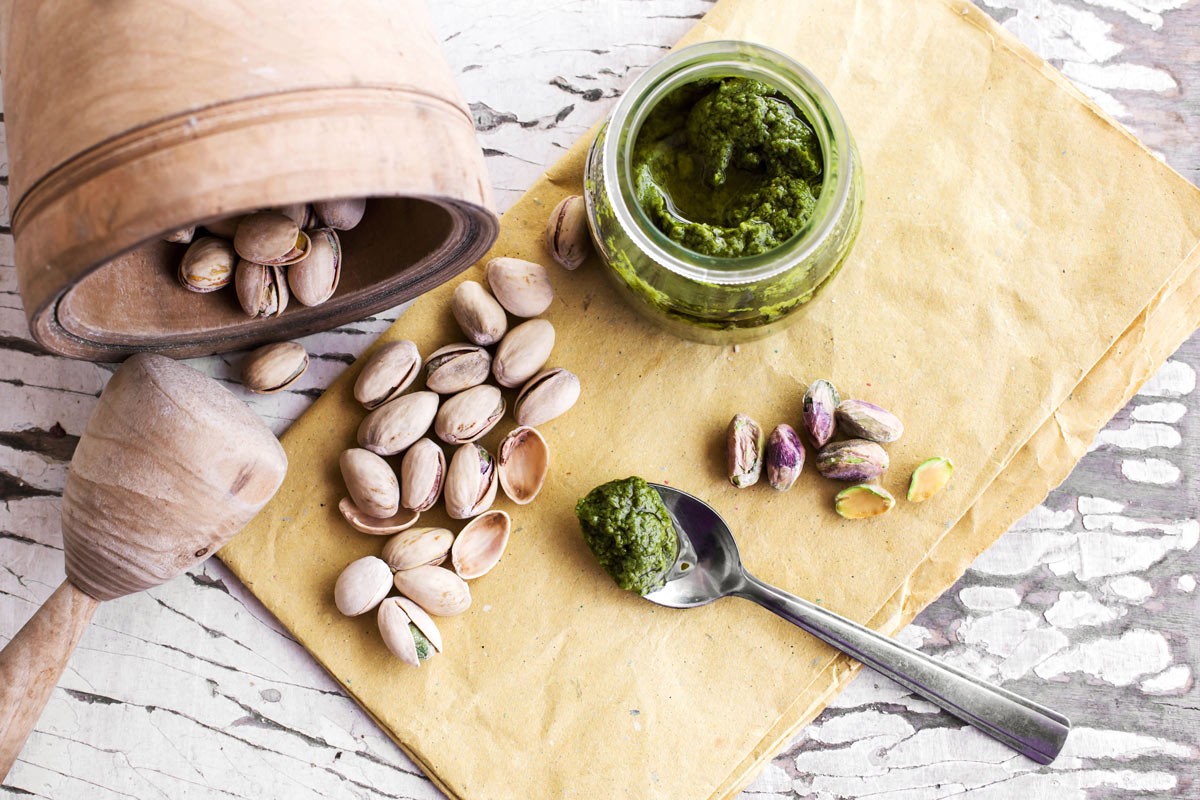 Chicken with Pistachio Pesto As my team knows, I love pistachio anything. And this version of pesto has earned a place in my repertoire. While my wife Meghan and I enjoy it on skin-on chicken thighs or breasts, it can be used on boneless skinless chicken pieces (or whole birds) as well. Leftovers are amazing on bruschetta, on sandwiches,… view recipe
Chicken with Pistachio Pesto As my team knows, I love pistachio anything. And this version of pesto has earned a place in my repertoire. While my wife Meghan and I enjoy it on skin-on chicken thighs or breasts, it can be used on boneless skinless chicken pieces (or whole birds) as well. Leftovers are amazing on bruschetta, on sandwiches,… view recipe Roasted Monkfish with Burst Cherry Tomatoes and Olives Monkfish, sometimes called “poor man’s lobster,” is deliciously meaty. If you can’t find it, substitute grouper, swordfish, halibut, or tuna. Greens sautéed with garlic or a green salad would make a nice accompaniment. Ingredients Extra virgin olive oil 1 1/2 pounds monkfish fillets 1 cup cherry tomatoes 1/2 cup brined Castelvetrano olives, pitted 1 lemon,… view recipe
Roasted Monkfish with Burst Cherry Tomatoes and Olives Monkfish, sometimes called “poor man’s lobster,” is deliciously meaty. If you can’t find it, substitute grouper, swordfish, halibut, or tuna. Greens sautéed with garlic or a green salad would make a nice accompaniment. Ingredients Extra virgin olive oil 1 1/2 pounds monkfish fillets 1 cup cherry tomatoes 1/2 cup brined Castelvetrano olives, pitted 1 lemon,… view recipe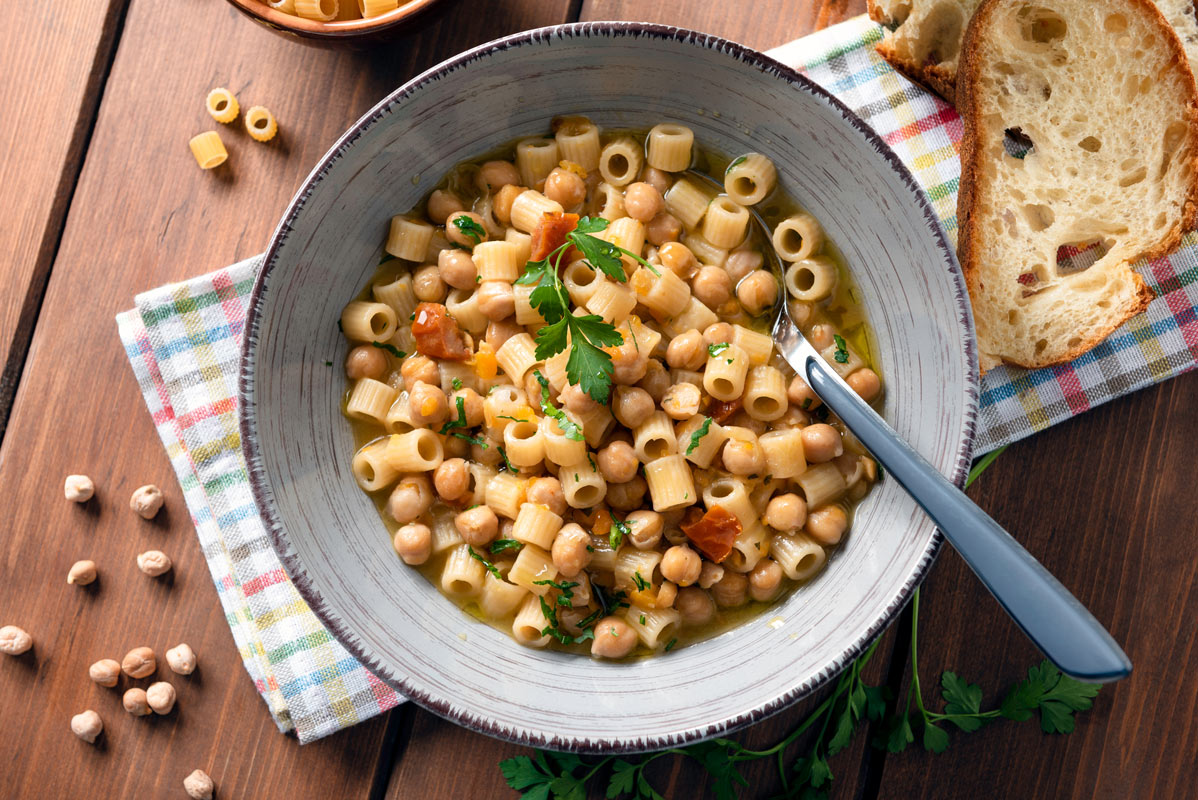 Pasta e Ceci This popular Roman soup pairs small tube-shaped pasta and chickpeas. Using broth instead of water, along with a Parmigiano-Reggiano cheese rind, really amps up the flavor—save your leftover rinds in the freezer to drop in stews as well as soups. You can also adjust the ratio of chickpeas to pasta as you like. Ingredients 2 tablespoons… view recipe
Pasta e Ceci This popular Roman soup pairs small tube-shaped pasta and chickpeas. Using broth instead of water, along with a Parmigiano-Reggiano cheese rind, really amps up the flavor—save your leftover rinds in the freezer to drop in stews as well as soups. You can also adjust the ratio of chickpeas to pasta as you like. Ingredients 2 tablespoons… view recipe Baked Acorn Squash with Asiago Flan and Fried Sage Leaves Squash stuffed with a cheesy flan is a beautiful cool weather dish, whether served as a side or as a meatless entrée. Feel free to use other varieties of squash, though baking times will vary according to their size. Ingredients For the squash: 2 acorn squash Extra virgin olive oil Coarse salt (kosher or sea)… view recipe
Baked Acorn Squash with Asiago Flan and Fried Sage Leaves Squash stuffed with a cheesy flan is a beautiful cool weather dish, whether served as a side or as a meatless entrée. Feel free to use other varieties of squash, though baking times will vary according to their size. Ingredients For the squash: 2 acorn squash Extra virgin olive oil Coarse salt (kosher or sea)… view recipe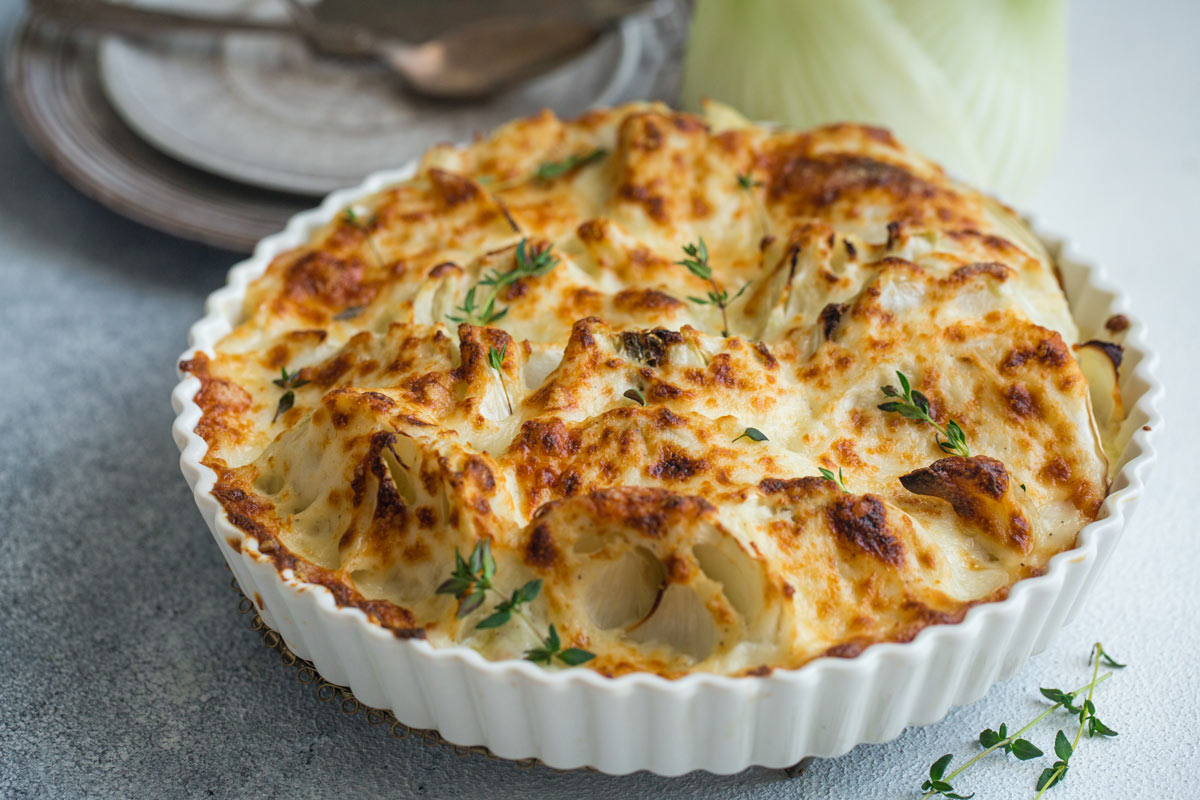 Fennel au Gratin A member of the carrot family (though its bulbs grow above ground), anise-y tasting fennel is a popular ingredient in southern Italy. This easy gratin is a good accompaniment to roast meat or chicken. Ingredients 3 large fennel bulbs 4 tablespoons extra virgin olive oil, divided use, plus extra for oiling a casserole dish 2… view recipe
Fennel au Gratin A member of the carrot family (though its bulbs grow above ground), anise-y tasting fennel is a popular ingredient in southern Italy. This easy gratin is a good accompaniment to roast meat or chicken. Ingredients 3 large fennel bulbs 4 tablespoons extra virgin olive oil, divided use, plus extra for oiling a casserole dish 2… view recipe Shrimp Marsala Marsala is a wine made near the town of the same name in Sicily using local white grapes for a sweet flavor profile. Shrimp are a great alternative to the classic chicken preparation. Ingredients 1 1/2 pounds peeled raw shrimp, rinsed and patted dry 1/4 cup all-purpose flour, more if needed 4 tablespoons extra virgin… view recipe
Shrimp Marsala Marsala is a wine made near the town of the same name in Sicily using local white grapes for a sweet flavor profile. Shrimp are a great alternative to the classic chicken preparation. Ingredients 1 1/2 pounds peeled raw shrimp, rinsed and patted dry 1/4 cup all-purpose flour, more if needed 4 tablespoons extra virgin… view recipe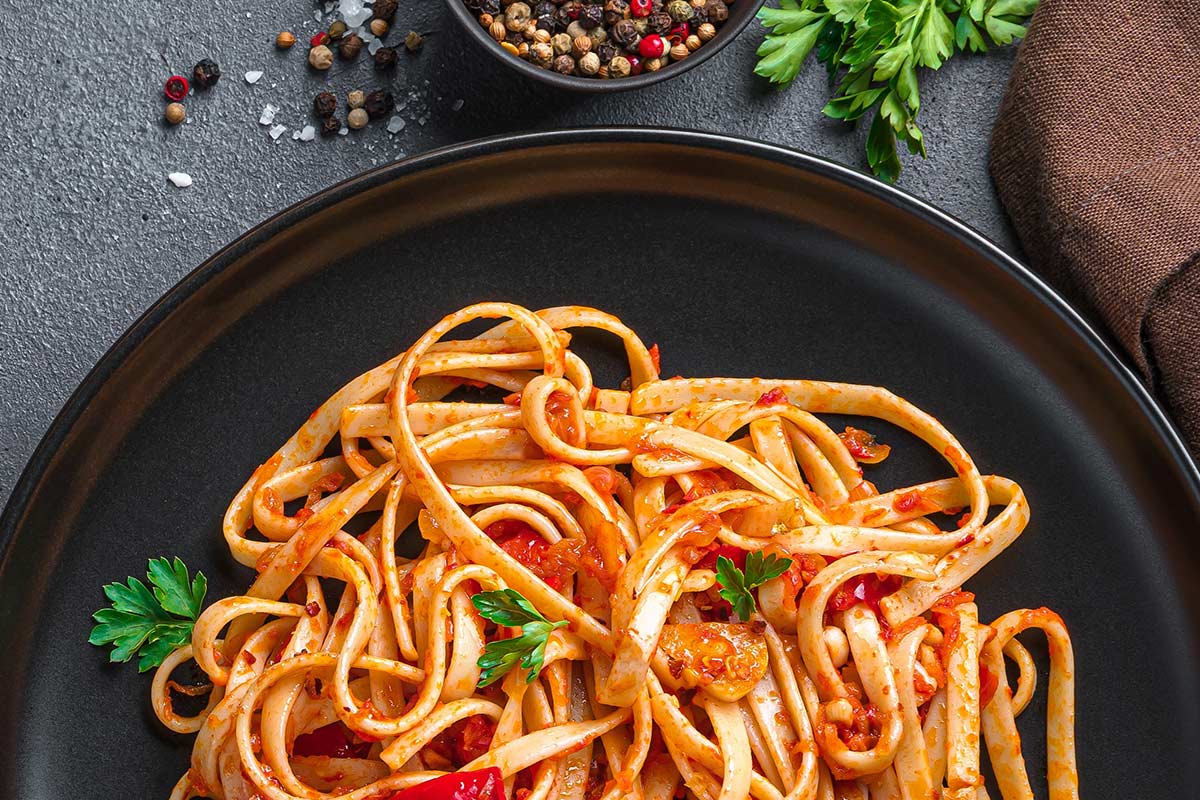 Pasta with Breadcrumbs (Pasta con Mollica di Pane) Also known as pasta ca’ muddica in Sicily, this southern Italian dish is rustic food at its best. My version enhances it with walnuts and diced tomatoes. Though the breadcrumbs stood in for cheese when the latter wasn’t affordable, feel free to serve with freshly grated Parmigiano-Reggiano or Pecorino Romano. Ingredients 1 pound linguine 2… view recipe
Pasta with Breadcrumbs (Pasta con Mollica di Pane) Also known as pasta ca’ muddica in Sicily, this southern Italian dish is rustic food at its best. My version enhances it with walnuts and diced tomatoes. Though the breadcrumbs stood in for cheese when the latter wasn’t affordable, feel free to serve with freshly grated Parmigiano-Reggiano or Pecorino Romano. Ingredients 1 pound linguine 2… view recipe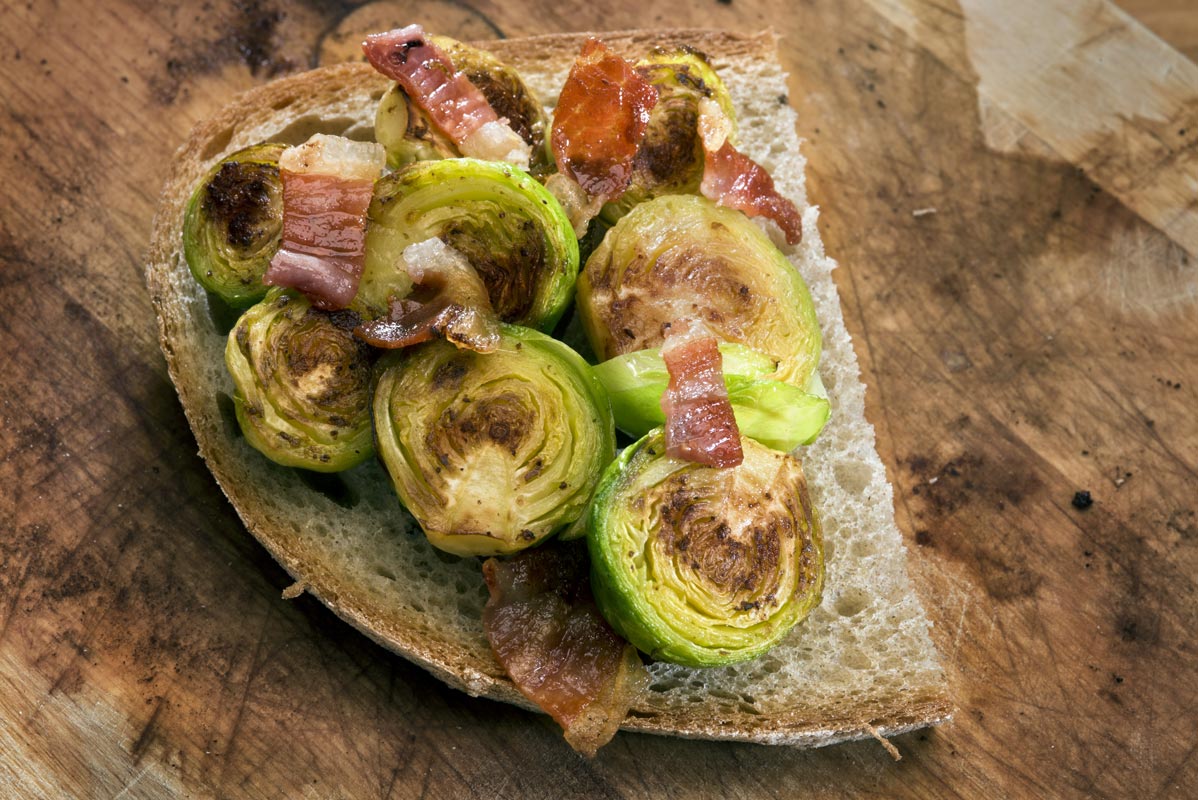 Brussels Sprouts Crostini with Pancetta and Balsamic Although they’re named after a Belgian city, this popular member of the brassica family is thought to have been first cultivated in Rome. To shave the sprouts safely, I recommend using the thinslicing disk on your food processor—not a mandoline or knife. Ingredients 12 slices of day-old Italian bread or a French baguette (sliced on… view recipe
Brussels Sprouts Crostini with Pancetta and Balsamic Although they’re named after a Belgian city, this popular member of the brassica family is thought to have been first cultivated in Rome. To shave the sprouts safely, I recommend using the thinslicing disk on your food processor—not a mandoline or knife. Ingredients 12 slices of day-old Italian bread or a French baguette (sliced on… view recipe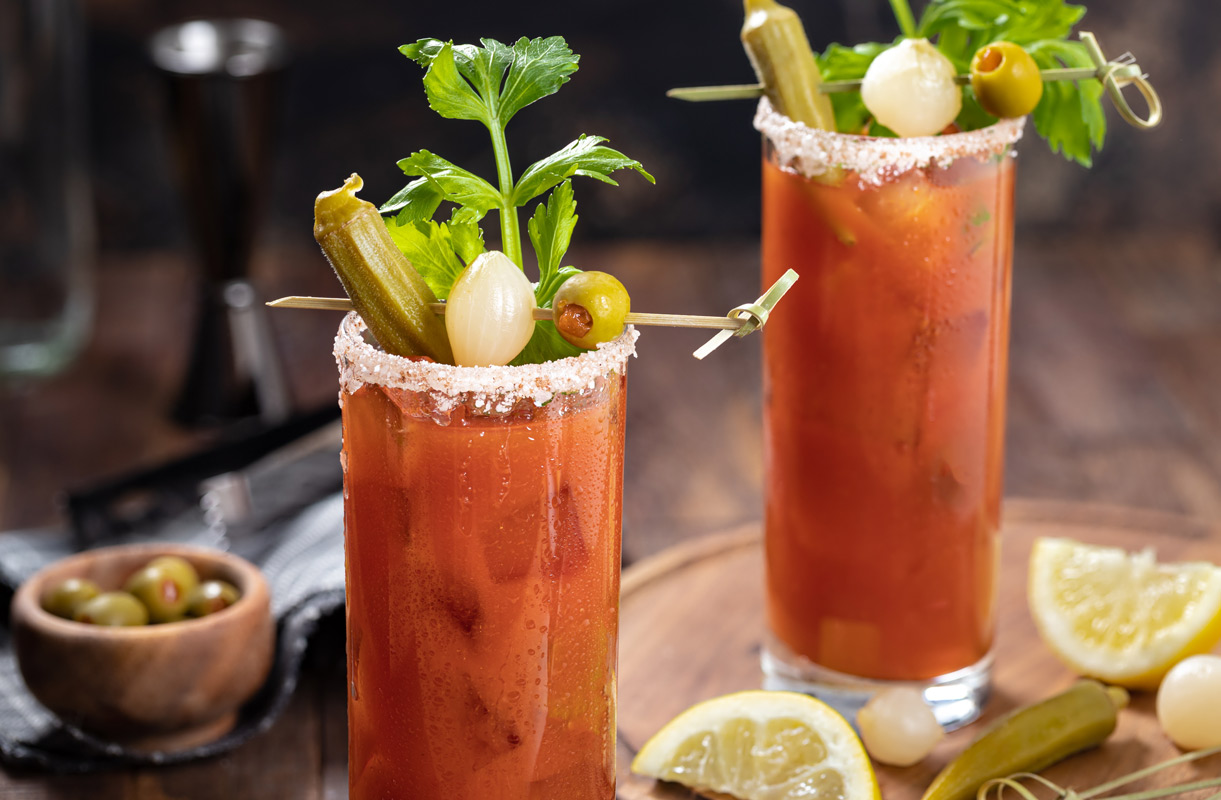 Bloody Mary Nothing sets the tone for a festive day—or a leisurely one—better than a well-made Bloody Mary. It starts with a homemade mix with just the right amounts of spice and acid—so much zestier than commercial mixes. And the bright and bountiful skewers will really impress your guests. Ingredients For the mix: One 46-ounce can or… view recipe
Bloody Mary Nothing sets the tone for a festive day—or a leisurely one—better than a well-made Bloody Mary. It starts with a homemade mix with just the right amounts of spice and acid—so much zestier than commercial mixes. And the bright and bountiful skewers will really impress your guests. Ingredients For the mix: One 46-ounce can or… view recipe
